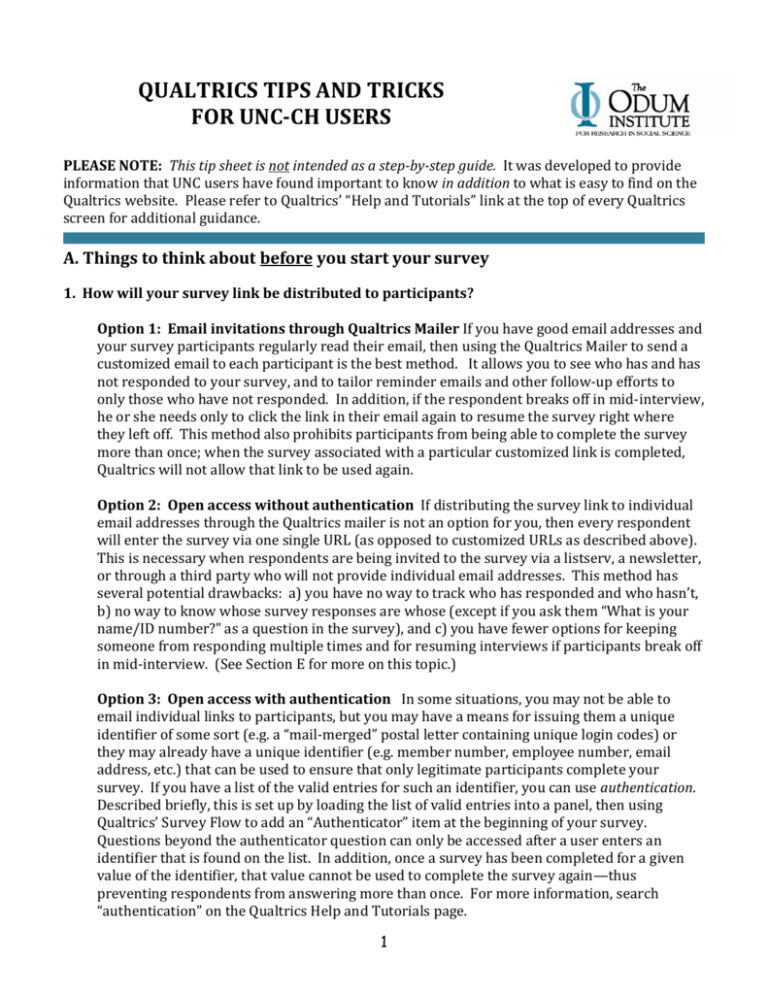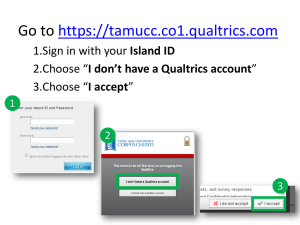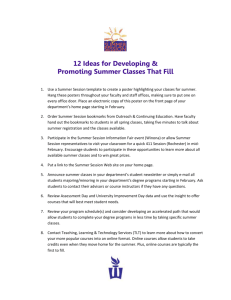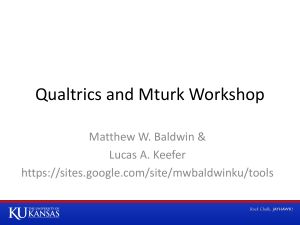Qualtrics Tips and Tricks
advertisement

QUALTRICS TIPS AND TRICKS
FOR UNC-CH USERS
PLEASE NOTE: This tip sheet is not intended as a step-by-step guide. It was developed to provide
information that UNC users have found important to know in addition to what is easy to find on the
Qualtrics website. Please refer to Qualtrics’ “Help and Tutorials” link at the top of every Qualtrics
screen for additional guidance.
A. Things to think about before you start your survey
1. How will your survey link be distributed to participants?
Option 1: Email invitations through Qualtrics Mailer If you have good email addresses and
your survey participants regularly read their email, then using the Qualtrics Mailer to send a
customized email to each participant is the best method. It allows you to see who has and has
not responded to your survey, and to tailor reminder emails and other follow-up efforts to
only those who have not responded. In addition, if the respondent breaks off in mid-interview,
he or she needs only to click the link in their email again to resume the survey right where
they left off. This method also prohibits participants from being able to complete the survey
more than once; when the survey associated with a particular customized link is completed,
Qualtrics will not allow that link to be used again.
Option 2: Open access without authentication If distributing the survey link to individual
email addresses through the Qualtrics mailer is not an option for you, then every respondent
will enter the survey via one single URL (as opposed to customized URLs as described above).
This is necessary when respondents are being invited to the survey via a listserv, a newsletter,
or through a third party who will not provide individual email addresses. This method has
several potential drawbacks: a) you have no way to track who has responded and who hasn’t,
b) no way to know whose survey responses are whose (except if you ask them “What is your
name/ID number?” as a question in the survey), and c) you have fewer options for keeping
someone from responding multiple times and for resuming interviews if participants break off
in mid-interview. (See Section E for more on this topic.)
Option 3: Open access with authentication In some situations, you may not be able to
email individual links to participants, but you may have a means for issuing them a unique
identifier of some sort (e.g. a “mail-merged” postal letter containing unique login codes) or
they may already have a unique identifier (e.g. member number, employee number, email
address, etc.) that can be used to ensure that only legitimate participants complete your
survey. If you have a list of the valid entries for such an identifier, you can use authentication.
Described briefly, this is set up by loading the list of valid entries into a panel, then using
Qualtrics’ Survey Flow to add an “Authenticator” item at the beginning of your survey.
Questions beyond the authenticator question can only be accessed after a user enters an
identifier that is found on the list. In addition, once a survey has been completed for a given
value of the identifier, that value cannot be used to complete the survey again—thus
preventing respondents from answering more than once. For more information, search
“authentication” on the Qualtrics Help and Tutorials page.
1
2. Will your survey have multiple pages or all questions on one page?
A good guideline is to put 1 to 3 questions per page. Why? Because you want the task of
responding to be as easy as possible. That means not requiring your respondent to scroll up
and down to find all the questions. Try to put only as many questions on one page as the
typical respondent can see on one screen without scrolling. You should also remember that
responses are only saved to the database when the respondent clicks the button to
proceed to the next screen. So if you put 20 questions on one screen and something
unfortunate happens when a respondent is answering question 19 (let’s say a power failure or
accidental close of the browser window) or if he/she closes the browser window, then those
19 pieces of data have not been saved. When (if) your respondent resumes her survey, she
will have to answer those 19 questions again. If those 20 questions had been spread onto 10
screens of two items each, she would have lost at most 2 items.
3. What tool(s) will you use to analyze your data and prepare your report(s)?
Qualtrics provides tools for online analysis, but they are very basic—frequency distributions
and crosstabulations primarily. If this is all your project requires, you can consider using
Qualtrics for your analyses, but be cautious. Some UNC-CH users have been disappointed to
complete their surveys and set about generating their reports only to find that Qualtrics can’t
quite subset the data or perform exactly the analyses they need. The reporting tool can
generate snazzy graphics (pie charts, histograms, etc.) with the click of a button, but before
embarking on a Qualtrics survey assuming you will do online analyses, make sure that it has
the capability to do exactly what your project needs.
From Qualtrics, you can easily download your data into an SPSS dataset or into a comma
separated values (.csv) file that can be read by Microsoft Excel and several other programs.
B. Creating your Survey
Creating a survey in Qualtrics is generally an intuitive process, but there are a couple of
exceptions. We provide guidance for those non-intuitive situations below.
To create a page with only information (text) and no questions (such as a survey welcome or
introduction page), create a “question” of the type Text/Graphic.
Unless there is a specific reason not to, include a Back button so that respondents can back
up to correct answers if they make an error. To add a back button, click “Survey Options”
and check the appropriate box.
If you want the question to contain text from a previous question (sometimes referred to as
“piping”), click the question text area. The box will turn yellow and a blue tab will appear
above it that says “Rich Text Editor.” Click this. In the dialog box that opens, use the “Smart
Text” icon (which has the symbol “{a} on it”) and follow the prompts. Click anywhere
outside the dialog box to save your changes and return to the main screen. (You would use
this feature if, for example, you asked the respondent to choose his/her favorite vegetable
from a list and he chose “carrots” and you wanted the next question to reflect that choice, as
in “How often do you eat [carrots]?”)
2
If you want the response categories to be dependent on what the respondent did or didn’t
select in a previous question, click on the survey question, then click on the purple box next
to the question and select “Carry Forward Choices”.
Under “Validation,” use the “Force Response” option carefully. If you select this option, the
respondent will not be able to proceed with the survey unless they provide an answer. A
respondent who wants to skip a particular question and can’t may decide to stop the survey
altogether. Most IRB approvals at UNC-CH require that the respondent be allowed to skip
questions they don’t want to answer. (Note: some researchers prefer to require a response
to every question but to include “Don’t Know” and/or “Decline to Answer” as response
categories on every question. This is acceptable, but be aware that in most cases, making
these categories visible on the screen will result in more respondents choosing them than if
they are not visible and respondents who do not want to answer are just allowed to leave the
question blank.)
Here are some tips regarding the “Look and Feel” of your survey.
Notice that on the right side of this dialog box, there is a drop-down menu for “Look and Feel
Library”. In the “Odum” library, there is a single format with white background and Carolina
blue accent which has been created specifically for UNC. You may also use any of the formats
available in the “Qualtrics” look and feel library.
Some of the Qualtrics style formats offer a version with multiple questions per page and a
version with a single question per page. In actuality, any format can be turned into a single
question per page format simply by adding a page break after each question.
C. Adding Skip Logic and Display-if Logic
“Logic” refers to the situation where some respondents follow one path through a questionnaire
while others follow a different path. For example, if part of your questionnaire asks about recent
experiences in a dentist’s office, you may want to ask those questions only if a respondent has
visited a dentist in the past 12 months. To do this, you would first ask a “gate” question such as
“Have you visited a dentist in the past 12 months?” The detailed questions would be asked only if
the respondent had seen a dentist during the past 12 months; otherwise the respondent would be
“skipped” over these questions and on to the next topic in the survey.
Here are some tips regarding Skip Logic and Display-if Logic:
Enter all the survey questions involved in the logic first. Then add the skip and display-if
instructions.
You can have multiple skip instructions one after another. During survey administration,
they will be processed in the order you place them in.
3
Be sure to test all logic carefully! Preview the survey several times and test that the logic
functions as intended for all possible responses.
You will not be able to delete an item to which your skip or display-if logic points. Change or
delete the logic first, then delete the item you want to remove.
D. Previewing Your Survey
You can see what your survey is going to look like to respondents by choosing “Preview Survey.”
To allow other persons to preview the survey before it is activated (e.g. your advisor, research
collaborator, etc.), highlight and copy the URL from the preview browser window and send it to
them. Note that the URL will be very long; if their email system doesn’t support the “point and
click” feature for multi-line URLs, they may need to highlight and copy the URL and paste it into
their browser window.
IMPORTANT NOTE: Before fielding your survey, delete any data that have accumulated from
previewing/testing the survey instrument. Click on “View Results” on the top row of tabs and then
click the “Responses” icon. Make sure the tab for “Recorded Responses” is selected (as opposed to
“Responses in Progress.”) A list of all data records will appear at the bottom of the screen. Click
“Advanced Options” and select “Delete Survey Previews.” If you have used the Qualtrics feature to
create test data, repeat and select “Delete Survey Tests.”
E. Resuming Partial Interviews, “Ballot Box Stuffing” and Other “Survey Options”
One of the most commonly-asked questions by UNC Qualtrics users is “What happens if a
respondent stops in mid-survey and wants to finish it later?” The answer to this question depends
on three things: 1) whether you use the Qualtrics mailer to invite participants to the survey via a
customized email, 2) whether you check the “Save and Continue” box on the “Survey Options” page,
and 3) the option you select under “Partial Completion” on the Survey Options page.
Inviting participants via the Qualtrics mailer allowed respondents to access the survey via their
own unique URL within their message. In this case, they can break off and resume the survey by
clicking the link in their email again at any point up to the expiration date of their link (see Section
G). Qualtrics keeps track of where they left off and takes them straight back to that page. This
happens regardless of whether the "Save and Continue" box on the Survey Options page is checked,
and regardless of what computer the respondent uses to access the survey. (However, you should
make sure that under “Survey Protection” on the “Survey Options” page, you have selected “Only
allow those who receive invitation emails to take the survey.”)
The “Partial Completion” setting on the Survey Options page also affects how break-offs are
handled. When a respondent answers part of a survey but not all of it, Qualtrics stores those data in
a special “holding” area; they are not accessible in your results data file. Once they are written to
the results data file, the respondent will no longer be able to resume that interview. The dropdown
box on the Survey Options page determines how long Qualtrics “holds” partial data records before
writing them to the final data file.
4
In general, it is recommended to select the longest interval available for this setting (currently 6
months). In this case, the respondent has 6 months after the last time they accessed the survey to
come back to it and resume where they left off. If they do not do so within 6 months, the partial
data will be written to the data file and they will no longer be able to resume. (In addition, when
you deactivate your survey at the close of data collection, all partial data records that aren’t already
in the data file will added.)
If you plan to distribute your invitations via the Qualtrics mailer, do not read the rest of this
section—it will only confuse you unnecessarily!
If you do not use the Qualtrics mailer to issue survey invitations, then how Qualtrics handles breakoffs and resumptions in the survey is affected by the “Save and Continue” option and the “Prevent
Ballot Box Stuffing” option on the Survey Options page. If the “Save and Continue” box is checked,
then Qualtrics attempts to store a cookie on the respondent’s computer. If it succeeds, then when
the respondent returns to the survey URL from that username on that computer, it will take them
directly to where they left off. If, however, the respondent has disallowed cookies on their
computer, then they will not be able to resume where they left off. Rather, when they go to the
survey link a second time, they will have to start the survey all over again.
If the “Save and Continue” box is not checked, then each time a respondent goes to the survey URL,
the survey will start at the beginning.
HOWEVER: There is another setting which comes into play when a respondent goes to the survey
URL a second time. Also on the “Survey Options” page, there is a check box for “Prevent Ballot Box
Stuffing.” If the cookie on the respondent’s computer indicates that this survey has already been
completed, then Qualtrics will not allow the survey to be completed again from that machine and
will present a message to that effect. This is a good measure if you are sure that no two of your
respondents will need to complete the survey from the same machine, but can cause problems if
they do.
SPECIAL NOTICE CONCERNING MULTIPLE USERS TAKING THE SURVEY FROM THE SAME
COMPUTER: Sometimes surveys are administered to several people using the same computer—
such as a “kiosk” in a waiting room where patients are asked to complete a survey on their way in
or out of the clinic. In this case, make sure that neither the “Save and Continue” nor the “Prevent
Ballot Box Stuffing” is checked. If “Save and Continue” is checked, then if one participant stops in
mid-survey, the next person’s survey will start where they left off rather than at the beginning. If
“Prevent Ballot Box Stuffing” is checked, then only the first participant will be able to complete the
survey; the second and subsequent attempts will be met with an error message stating that the
survey has already been completed.
5
F. Your Library
The Library is where you create and store items related to, but separate from, your survey
questionnaire. These include:
End of Survey Messages (the screen respondents see after submitting their answer to the final
survey question)
Graphic image files for use in your survey or messages
Invitation Emails (necessary for using the Qualtrics mailer)
Lists of Respondent Email Addresses (called “Panels”)
For information on these topics, see the Help and Tutorials links.
G. Distributing your Survey
Here is a quick summary of the steps to distribute your survey via the Qualtrics survey mailer (i.e.
individualized email invitations to each participant). For more information or if you are not using
the Qualtrics mailer, see the Qualtrics Help information.
1. In your Library, create the Panel of respondents (typically by uploading a .csv file which can be
easily created using the “File/Save As” menu option in Microsoft Excel).
2. In your Library, create the text of the invitation email.
3. Under “Distribute Survey”, click on “Send Survey” and then choose the tab for “Survey Mailer”
and follow the prompts.” When creating this mailing, keep the following in mind:
By default, the individualized links generated by the Qualtrics mailer will expire 60 days
after the email invitation is sent. You can extend this to 90 days (or reduce it to fewer) in the
dropdown menu under “Advanced Options.” If you still want a respondent to be able to
complete their survey more than 90 days after their invitation, you will need to send them a
“reminder” email (see next section) which will contain a new link. (If a respondent clicks on
the link in an email after the link has expired, the Qualtrics server will give an error message
saying that the “survey cannot be found”. )
IMPORTANT NOTE: There is a column on the Distribute Survey/Mail History screen that claims to
show how many email messages “failed.” Do not be deceived by this! As of this writing (September
2010), it is not an accurate report of your failed emails (sometimes called “bouncebacks”).
Unfortunately, when using the Qualtrics mailer, you have no way of knowing which emails bounced
back to the Qualtrics server. If you are concerned about inaccurate email addresses in your
distribution list, you may want to send a “prenotification” email to your participants a week or so in
advance from your own email account in order to identify bouncebacks. (Prenotification contact has
also been shown to improve survey cooperation rates.) The prenotification message can be very
short, explaining very briefly who you are, what you’re doing, and that the recipient should expect
an email on [fill in the date] inviting them to participate. An added bonus of the prenote is that if
the respondent knows the invitation is coming and doesn’t receive it (perhaps due to SPAM filters),
he/she can contact you about it.
6
SPAM filters/blockers. Sadly, there is no way to guarantee that your invitations reach your
participants’ inboxes; researchers are powerless over individuals’ SPAM filter settings. Qualtrics
works hard to keep their servers from getting onto any of the major blacklists in the U.S., but
individuals, internet service providers, and employers also have their own systems. There are no
magic bullets for getting through them. Two small hints are to not use special characters (including
“$”) in the subject line of the message and not to include graphical images in the email.
H. Sending Reminder Emails
To maximize the response rate to your survey, it is generally a good idea to send at least one
reminder email after a designated amount of time (e.g. 3 to 10 days, depending on your survey
population). If you use the Qualtrics survey mailer, you can easily send a message to only to the
persons who have not yet responded, saying “A week ago we sent you a survey invitation…We see
that you have not yet responded….etc.” To send such a reminder, select “Distribute Survey/Mail
History.” On the row showing the invitation you sent to your panel, click on the dropdown box at
the far right to choose “Send Reminder or Thank You” and follow the prompts.
I. Data Security and IRB Information
Qualtrics has been approved by the UNC Information Security Office for collecting and storing data,
including private health information (PHI) and other sensitive data. The UNC IRB is aware of this so
your IRB application needs to a) indicate that you will be using Qualtrics and b) focus on where the
data will be stored and security precautions you will take if/when you download your data from
Qualtrics.
Please be aware that by default, the Qualtrics system does capture and store the IP address used by
the respondent. While you will not see it using the online analysis tools, it will be included if you
download your data. To learn about disabling IP capture, search on “Anonymize Responses” in
Qualtrics Help.
J. Collaborating With Other UNC-CH Researchers
You can “share” a survey with another UNC-CH Qualtrics user so you both have access to it. To do
this, the original owner of the survey chooses “My Surveys” on the top row of tabs and then clicks
on the “Collaborate” icon next to the survey. A pop-up box allows the owner to designate which
user(s) are to be given access and what types of actions that user should be allowed to do (edit the
survey, view the results, etc.). When the collaborator logs into their Qualtrics account, on the “My
Surveys” page, there will now be a “Shared Surveys” section where the joint survey will appear.
Note that you do not have to “share” a survey with someone if all they need to do is preview or test
the survey as a respondent would see it. (See Section D for this.) Sharing a survey is to be used
when two or more persons are creating the survey, sending invitations, viewing results, etc.
7
K. Advanced Features
Qualtrics has many more capabilities that are beyond the scope of this document. Below we list just
a few that UNC—CH researchers have found helpful. See Qualtrics’ Help and Tutorials section for
more information on these and other advanced features.
Cascading Style Sheets (CSS) can be used for additional control over screen appearance
through your survey.
HTML tags can be used for additional control over text appearance and spacing. When
editing question text, you can click “View Source” to have direct access to the HTML source
code.
JavaScript can be added to any survey question to perform mathematical calculations,
change the labels on buttons for a single screen only, move the progress bar to the top of the
screen, and a myriad other things. Keep in mind that a few users may not have JavaScript
enabled in their browsers.
Randomization can be used to vary the order in which certain questions or blocks are
presented to respondents, or to present only a subset of items to each respondent.
L. If you need additional help…
1. Use the yellow “Get Help” button on any Qualtrics screen.
2. Email (support@qualtrics.com) or call Qualtrics at 1-800-340-9194 from 9am – 8pm Eastern.
3. Go to the Odum Institute walk-in consulting hours which are posted at
www.odum.unc.edu/qualtrics.
Prepared by
Revised Mar 2012
8



